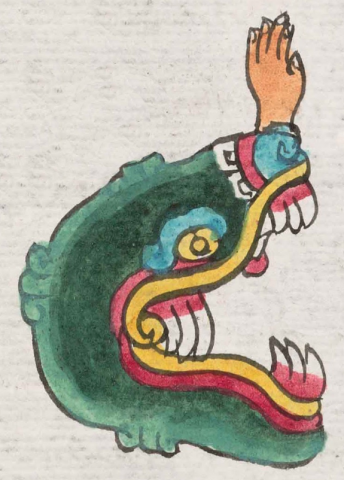Oztoman (Mdz18r)
This compound glyph for the place name Oztoman has two principal elements, an earth monster head, which serves to indicate a cave (oztotl), and a hand (maitl). The monster's head is in profile, looking to the viewer's right. The entrance to the cave is through the monster's open mouth. Its head is largely green (two-tone green), with some curling features on the top and back of its head and under the chin, reminiscent of stony outcroppings on a mountain. Its eye and nose are yellow, and its eyebrow is turquoise blue. The mouth is lined around the perimeter with yellow. There are three groups of white fangs with red gums, making it animal-like. The (left) hand is standing up, with the wrist attached to the monster's head at the nose. The hand is colored terracotta.
Stephanie Wood
The conceptualization of the earth monster shows a relationship between mouths and caves, with the cave as an access point to the underworld, the earth's interior. The earth monster appears in profile here, whereas in another version of the compound glyph for this place name we see its head in a frontal view (below right). Gordon Whittaker (Deciphering Aztec Hieroglyphs, 2021, 104) sees these are two separate glyphs for Oztoman, giving this one the transliteration OZTOa-man and the frontal one the transliteration OZTOb-man. The hand (maitl) provides the phonetic clue for the locative suffix -mān, "where there are," from the verb māni. The gloss apparently inadvertently omits the final "n" of the locative suffix (-man). Frances Karttunen also sees the verb mani, to extend, at play in this glyph. Thus, even though the gloss does not end in "n," the locative suffix preferred here is -man.
Stephanie Wood
oztoma.pup
Oztoman, pueblo
Stephanie Wood
c. 1541, or by 1553 at the latest
caves, cuevas, mouths, bocas, perfil, earth monsters, monstruos de la tierra, fangs, colmillos, topónimos, nombres de lugares, pueblos, altepetl

ozto(tl), cave, https://nahuatl.wired-humanities.org/content/oztotl
ma(itl), hand, https://nahuatl.wired-humanities.org/content/maitl
mani, extends or is located, https://nahuatl.wired-humanities.org/content/mani
-mān (locative suffix), where there are, https://nahuatl.wired-humanities.org/content/man
"Where Caves Are Found," (Gordon WHittaker, Deciphering Aztec Hieroglyphs, 2021, 104); "Cave Made by Hand" (Berdan and Anawalt, 1992, vol. 1).]
Codex Mendoza, folio 18 recto, https://digital.bodleian.ox.ac.uk/objects/2fea788e-2aa2-4f08-b6d9-648c00..., image 46 of 188.
The Bodleian Libraries, University of Oxford, hold the original manuscript, the MS. Arch. Selden. A. 1. This image is published here under the UK Creative Commons, “Attribution-NonCommercial-ShareAlike 3.0 License” (CC-BY-NC-SA 3.0)





